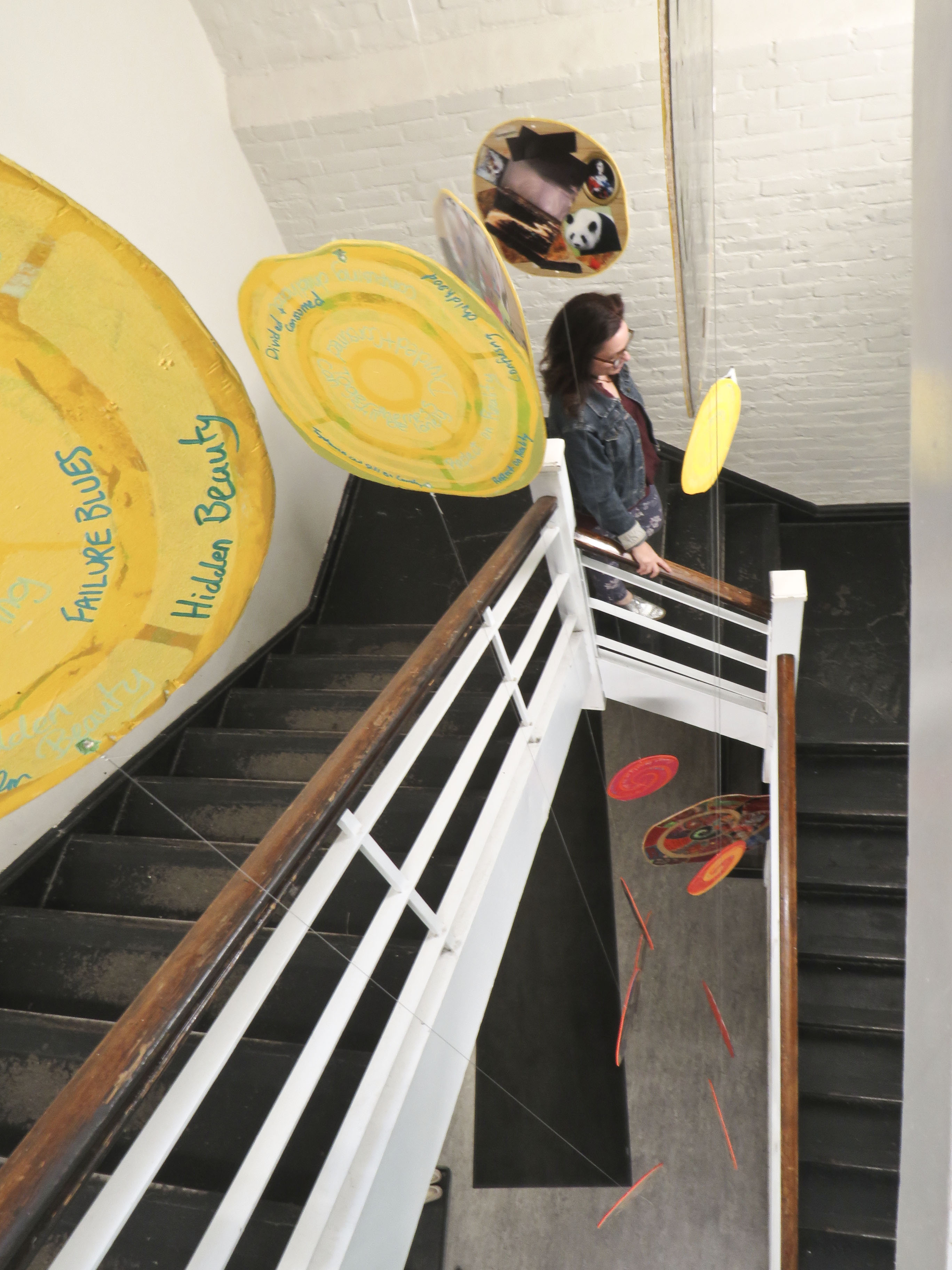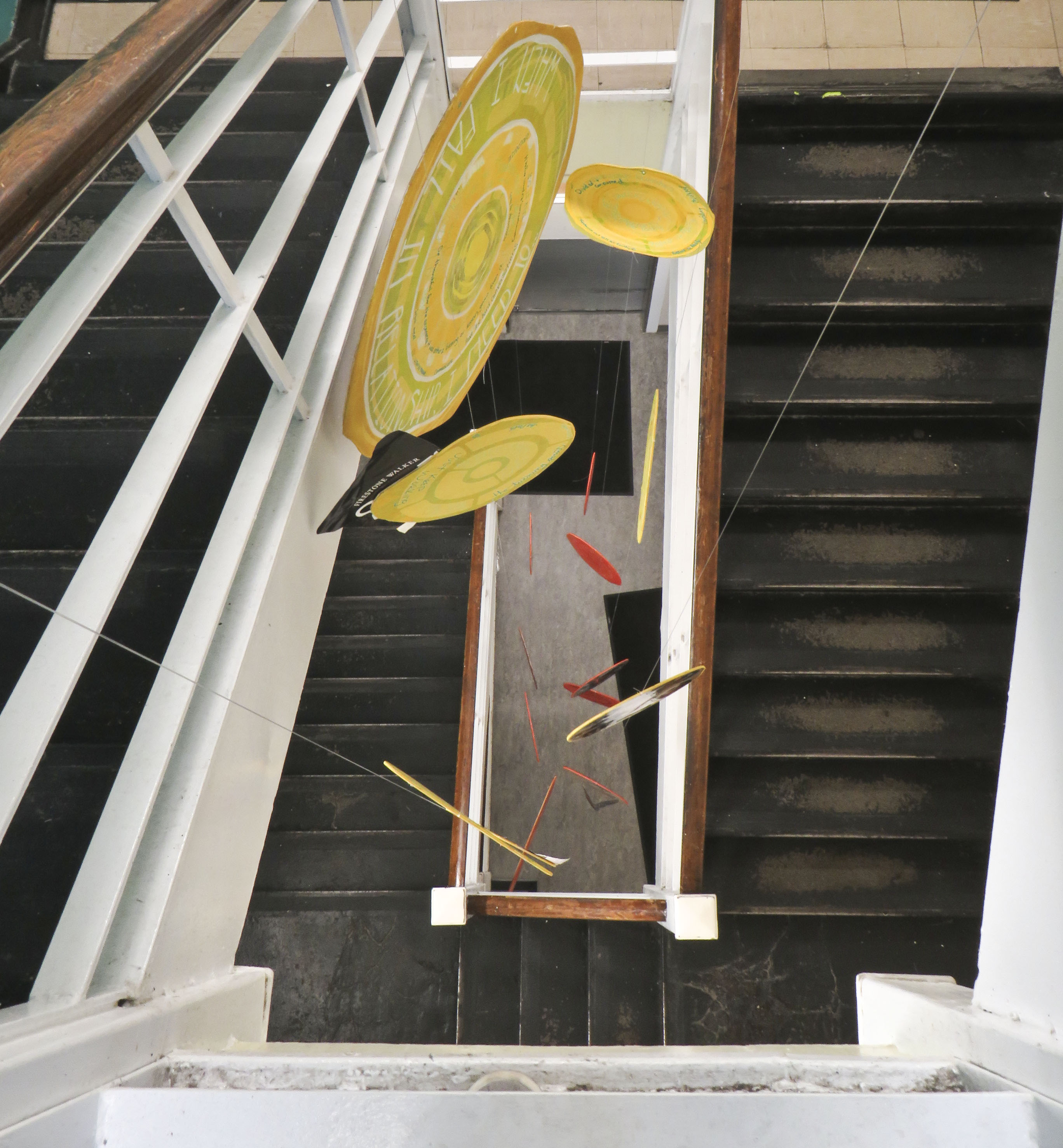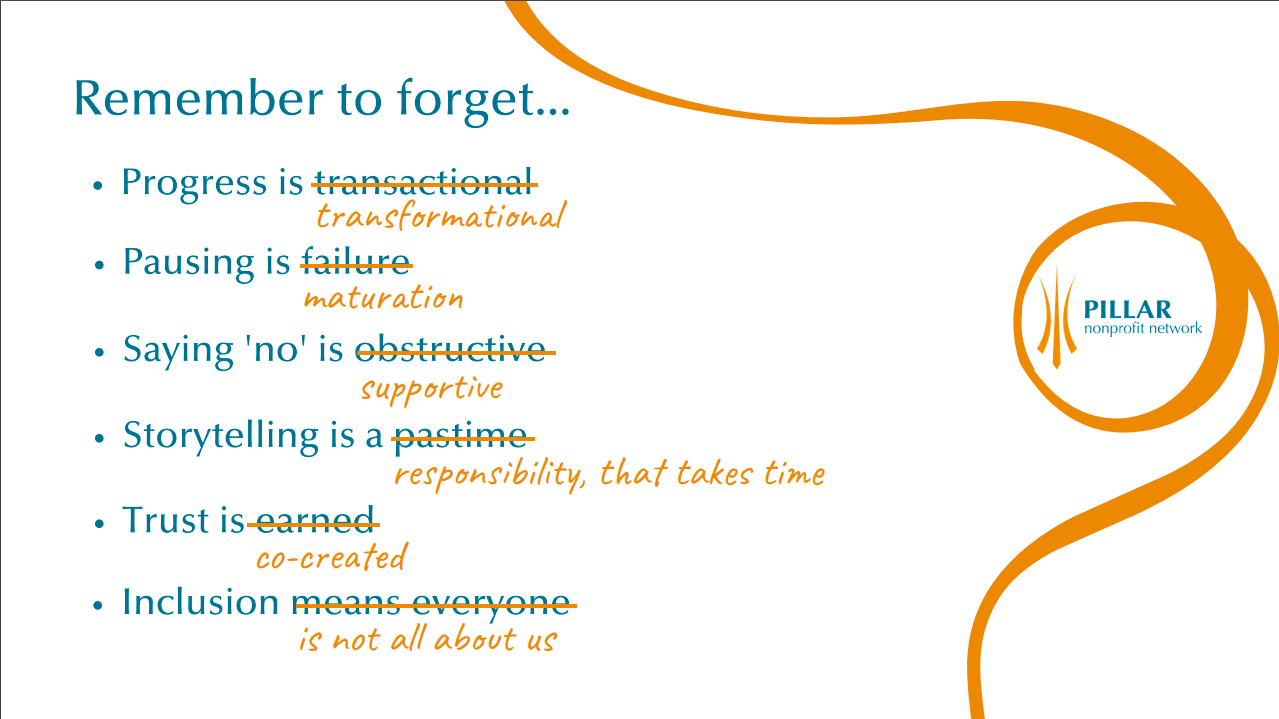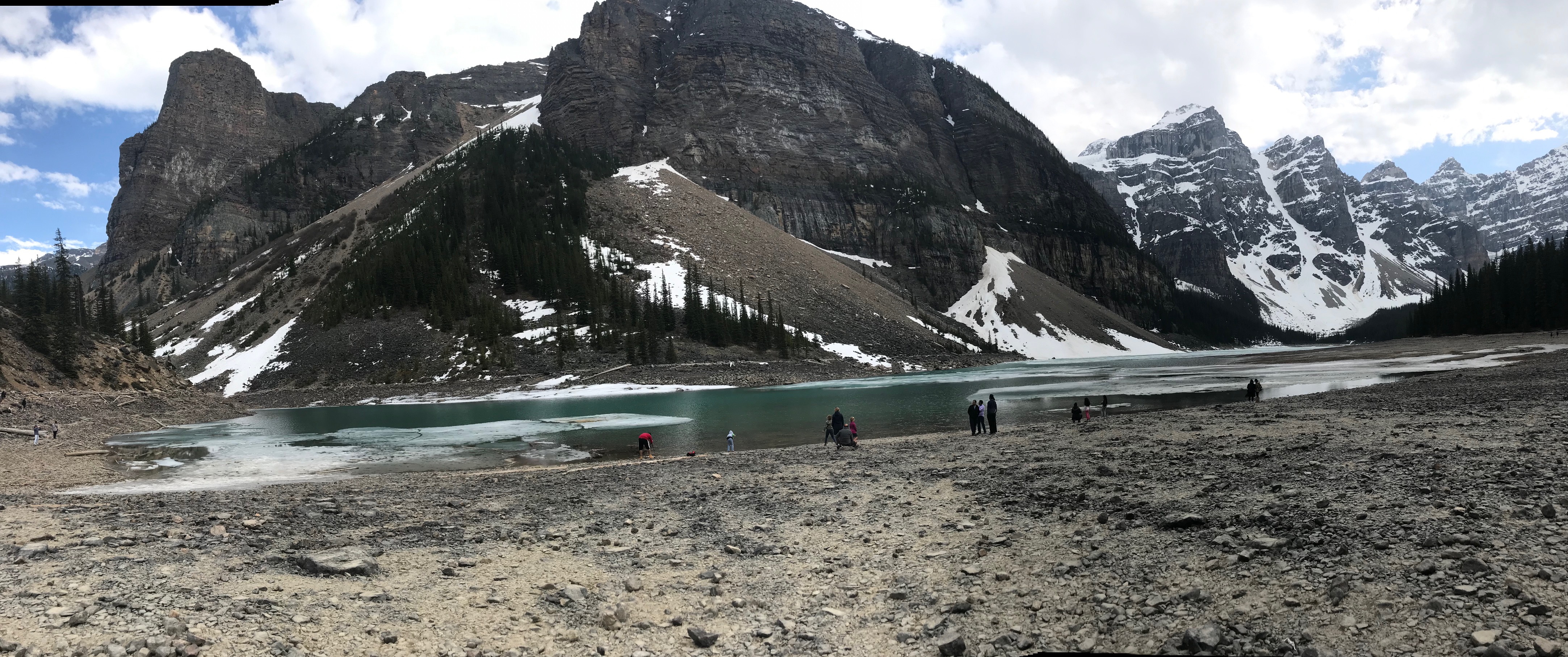#followthefellowship blog entry by Michelle Baldwin
How to Embed & Embrace Failure & Learning in Your Organization
Throughout my time as Executive Director of Pillar Nonprofit Network, the use of the word failure has been met with eye rolls, people shifting uncomfortably in their seats and outright debates about using the “f” word. While opening up on this topic is still taboo for some, at Pillar we pair failure with learning as a principle and believe it’s closely related to developing empathy as a core competency and as a connection to deep learning. We will take you on a journey to show how this approach has served our organization, all the while reflecting on our own failures and lessons learned along the way.
Aha Moment
I recall, in 2011, reading an essay on “Collective Impact” by Mark Kramer and John Kania and having one of my most memorable aha moments. The authors explore the notion that nonprofit organizations are set up to focus on their isolated impact, and posit that this is a systemic issue that stems from the way the sector is funded, and almost set up to make organizations compete with one another. I started to dig deeper into the systemic issues that can hold us back, as a sector, from creating transformational change. One issue that emerged was that nonprofits are funded with the expectation that they meet their targets. We define metrics for a project or program at the outset, and often there are not check-in points to adjust or pivot based on our “failures”or learning. If we are to find innovative solutions to wicked problems we need to be able to try new things and to reevaluate and change course as we go.
Sharing Mission Moments & Failure
These reflections led me to add a standing agenda item at our team meetings that would have everyone share both a “mission moment” and a “failure.” At first the team could not get their heads around sharing a failure with the whole team, and with me, on a bi-weekly basis. In the beginning, the failures were about time management and small slip-ups, but over time the failures shared began to contain more depth and reflection. Creating a safe and brave space to share our failures, and what we learned from them, significantly shifted our team culture. When teams are given permission to try new things, with the awareness and acceptance that they might fail, there is an openness to creativity and experimentation.
Developing a Team Alliance
During the development of our Team Alliance, upon reviewing our team’s strengths, it surfaced that positivity was a mindset held by many of our team members. We reflected on this and recognized that we had nurtured a bias for positivity that could potentially hinder us from raising valid concerns. To address this risk, we committed to having “get real” moments to talk about the hard stuff, knowing these conversations are essential to the healthy functioning and authenticity of our team. The Team Alliance was a turning point for us, because it fundamentally shifted our team culture to one that allowed us to be our true selves among our colleagues. We included the principle of failure as learning and the need to create and maintain a brave space in our Team Alliance. We regularly review and reflect on our commitments to each other at team meetings.
Failure Art Workshop & Installation
In 2018, we brought on a Director of Impact & Storytelling, who infused creativity into our exploration of failure and learning through a dynamic Failure Art Workshop developed in partnership with Social Arts with Melanie Schambach and with the Pillar staff team. The team was led through a collaborative and creative process that involved deep self-reflection, hands-on artistry and experiential learning activities. We examined failure as it relates to the self, interpersonal relationships, systems, and ideology. Our co-tenants at Innovation Works engaged with our collage pieces and added a title to the work based on their own interpretation of the art piece. The final product of this exercise was a 40-foot art mobile that now hangs in the stairwell of Innovation Works and serves as a reminder of the importance of this kind of reflective practice.


Impact & Failure Reports
Pillar created an Impact & Failure Report for the first time in 2017, based on examples set by Impact Hub Ottawa, and McConnell Foundation. It included the following themes and actions:
|
THEME |
ACTIONS |
|
Bias towards teaching rather than listening |
Prioritize inclusion and explore the benefits of mutual exchange |
|
Bias towards speed and success |
Implement impact measurement, data narratives, and apply decision-making tools |
|
Bias towards positivity |
Review Team alliance agreements quarterly and create room for quiet reflection |
|
Bias towards viewing failure as a “neck up” proposition |
Use creative modalities to explore the connection between power and failure |
Our 2018 Impact Report, titled, “What We’re Remembering to Forget (and learning in the process)” shared lessons including: 
What we are Remembering to Forget (and Learning in the Process) Impact 2018, Pillar Nonprofit Network
With each of these reconceived maxims, we included a key story that unpacked a narrative that was getting in our way and considered how we could rethink ways of being and doing that were not serving us in our mission. This Impact Report resulted from a process of collecting and analyzing team reflections, reviewing members’ feedback, and connecting with the Board.
My Failure & Learning Story
The biggest failure in my career came when we were building Innovation Works, a shared co-working space for social innovators in London, Ontario. This was an entrepreneurial adventure that saw more highs and lows than I had ever experienced. We were raising $2.2 million in grants and donations for this city building project and our municipality seemed like a natural fit for a leader and partner. We worked for one year with City Council and staff to create a strategy and business plan that aligned with the City’s priorities. Our timing, with a new progressive City Council sworn in, appeared to be ideal but then the budget process was dominated by a “nothing new” philosophy and the finance team recommended not supporting our request for $330,000. Our Board Chair and I were in front of City Council and were asked what we would do if we did not receive the money, or were only given $50,000. Our Board Chair said the project would go forward even if we have to sit on milk crates. I, however, stepped up to the microphone and insisted that we needed their full investment, asserting that for them to be a partner they would need to support the full request. We lost by one vote and it was devastating. It was in the media in a big way. The most challenging part was seeing the negative commentary about the nonprofit sector – the sector that we work so hard to raise the awareness and profile of in positive ways.
I recall waking up the next day with such a sense of defeat and sadness; I felt levelled as a leader. Ultimately, I was able to shift my thinking to embrace this as an entrepreneurial adventure and accept that there would be failures, and to recognize that my team and the community were watching me and my response. I told myself, “Your response will impact the momentum of this project.” It was in that moment that I decided to seize this as a learning opportunity. Fast-forward three weeks and we opened the mail to find an extraordinary donation from an anonymous donor who had read about our request to the city in the media and sent a cheque for the full $330,000. While there was a happy ending to this story of failure, the message I take from it was that we need to see entrepreneurial spirit and learning from failure as necessary elements of impact work and the building of resilient communities.
Future Failure & Learning
Failure is about perspective.
 When my study at the Banff Centre Foundations of Purpose program ended, I went out to be in nature and do some hiking. A few people suggested I visit Moraine Lake and when I got there the lake was low and I thought there was something wrong – climate change, maybe not enough snow this past winter. When I captured it in photos it looked bare, but when I zoomed in on the turquoise waters there was this picture perfect beauty. In asking the park staff, they informed me that it can take until the end of June for the water to fill in as the snow melts from the mountains. This example reminds me that perspective is everything; what I saw as a failure was in fact a normal nature cycle. We need to look closer, ask questions, and dig deeper to find the learning in failure.
When my study at the Banff Centre Foundations of Purpose program ended, I went out to be in nature and do some hiking. A few people suggested I visit Moraine Lake and when I got there the lake was low and I thought there was something wrong – climate change, maybe not enough snow this past winter. When I captured it in photos it looked bare, but when I zoomed in on the turquoise waters there was this picture perfect beauty. In asking the park staff, they informed me that it can take until the end of June for the water to fill in as the snow melts from the mountains. This example reminds me that perspective is everything; what I saw as a failure was in fact a normal nature cycle. We need to look closer, ask questions, and dig deeper to find the learning in failure.

Follow along #followthefellowship
